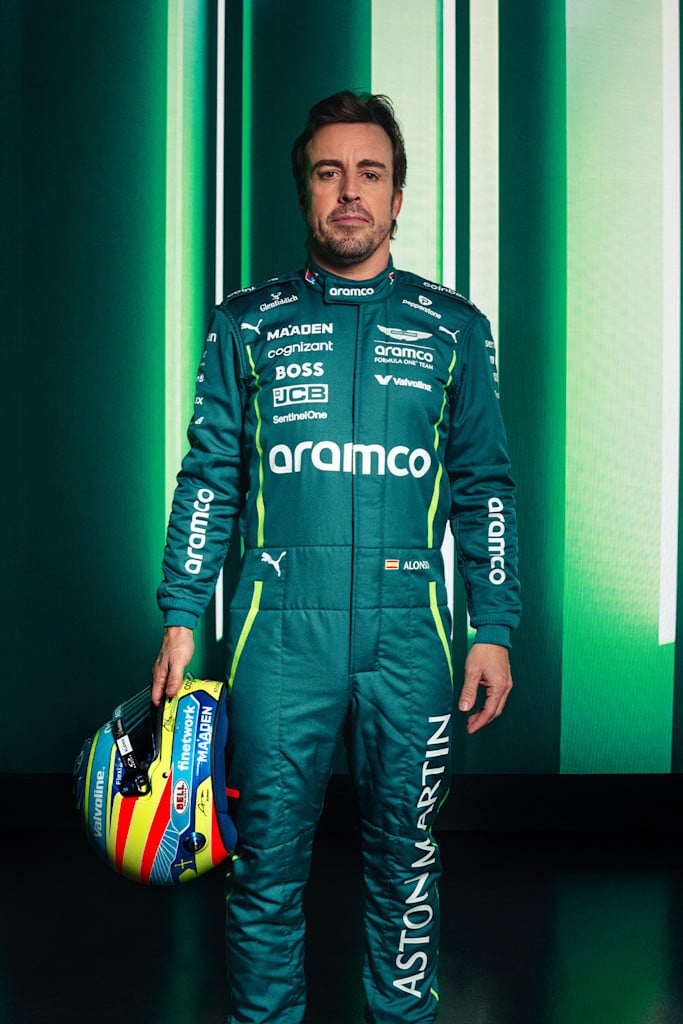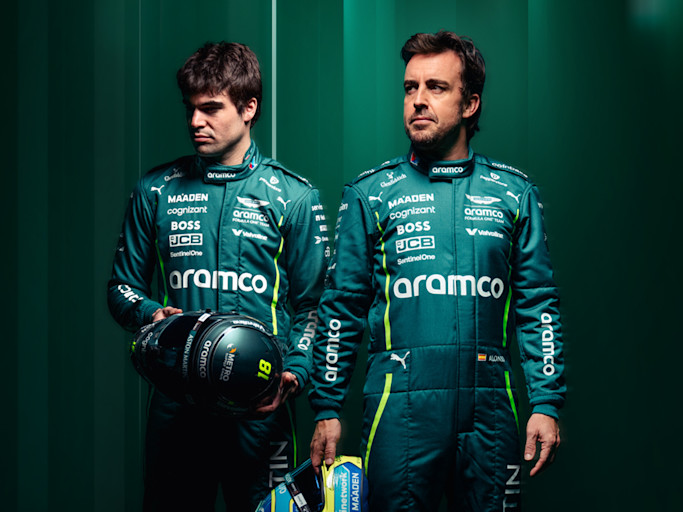Fernando made a strong impression in his debut season with minnows Minardi. In a car far from capable of scoring points, Fernando was able to dice with cars in the midfield, and on occasion outqualify them. He signed off his fledgling season as an F1 driver with an eye-catching drive at Suzuka, which saw him battle with future team-mate Giancarlo Fisichella, who was in a far superior Benetton, and finish ahead of several faster cars in 11th.
FernandoAlonso

Fernando Alonso
With more than two decades of experience as a Formula One driver, Fernando is one of the most complete drivers on the grid and he retains the same restless hunger for success and raw speed that have seen him win 32 Grands Prix and two Formula One drivers' titles.
Fernando rocketed up the junior categories: an early protégé of Adrian Campos, Fernando enjoyed title triumph in his debut racing season by winning the Euro Open by Nissan in 1999, before catching the eye of Minardi at the turn of the millennium – dovetailing an F1 test driver role with the outfit and an impressive rookie campaign in International Formula 3000.
This led to Fernando making his F1 debut with the Faenza-based team for 2001. Despite being equipped with uncompetitive machinery, Fernando displayed his raw talents to the world on multiple occasions, before joining Renault.
As a test driver for the team, Fernando racked up thousands of testing miles in 2002 and returned to a race seat for 2003. That year, he became the F1's youngest polesitter, podium finisher, race leader and race winner, beating decades-old records in the process.
In 2005, Renault's switch to a more conventional V10 engine layout paid dividends, as its R25 racer was competitive and, crucially, reliable from the outset of the campaign. Despite not having the speed of the McLaren MP4-20, Fernando's ruthless consistency resulted in him taking the title from Kimi Räikkönen with two races to spare – and saw him crowned the sport's youngest World Champion.
The dominance of Ferrari, Michael Schumacher and Bridgestone concluded with regulation changes introduced for the 2005 season, but the fearsome combination was on form once more in 2006. Fernando's first half of the season was imperious, finishing first or second in every race. Schumacher and Ferrari came on strong in the second half, assisted by some mechanical issues for Fernando, but Schumacher had reliability issues of his own in the final races and Fernando went on to become double World Champion.
A short stint at McLaren nearly resulted in a third-consecutive title, while a subsequent two-year spell back at Renault yielded just two further wins. Fernando joined Ferrari in 2010 and won on his debut in red, but ultimately missed out on the title by four points in a four-way title showdown.
Arguably Fernando's greatest season came in 2012, when he hauled himself into championship contention in a Ferrari that was uncompetitive in the opening races. Displaying the same raw speed, guile and ruthless consistency that took him to his first two titles, he kept in touch with drivers in faster cars until the final race of the season – missing out on title glory by three points to Sebastian Vettel following a dramatic showdown in São Paulo.
Ferrari's competitiveness dipped in 2013 and 2014, and Fernando switched to McLaren for its reunion with Honda. The project failed to prove successful, netting a handful of points off the back of dogged drives from Fernando, and the Spaniard called time on his F1 career at the end of 2018.
Having already starred in the 2017 Indianapolis 500, qualifying fifth and leading for 27 laps, Fernando underlined his prodigious talent behind the wheel by competing in a variety of disciplines. He raced in the World Endurance Championship's 'super season', winning it with Toyota and taking two victories in the Le Mans 24 Hours in the process. Fernando added two more attempts at the Indy 500, a Daytona 24 Hours win and a bid to win the Dakar Rally to his CV, before returning to F1 with Renault.
Newly rebranded as Alpine, Fernando reunited with the Enstone-based team for the 2021 season, and it did not take long until he was performing at an exceptionally high level – similar to the level prior to his retirement in 2018. He played a pivotal role in Alpine’s first Grand Prix victory in Hungary and scored a podium finish in Qatar, before going on to secure a front-row start at the 2022 Canadian Grand Prix in a year where reliability woes blunted his typically determined and impressive performances.
Sharing the same values, aims and ambitions as Aston Martin F1, a partnership seemed natural – and Fernando joined the team in 2023 on a multi-year deal. His speed and experience, paired with the team's AMR23, delivered results instantly – podiums were regular in the first half of the season, and he doggedly fought to more silverware as the season progressed. His most memorable top-three finish came in a fight to the chequered flag at Interlagos.
Fernando continued battling for points throughout the 2024 season, racking up thirteen top ten finishes and helping the team to fifth in the constructors' standings. He pushed the AMR24 to its maximum on multiple occasions, even with challenges that the team faced. In Mexico, he achieved his 400th Grand Prix weekend – an unparalleled, historic moment for the sport. He then rounded out the year with back-to-back points in Qatar and Abu Dhabi.

Whatever you do in life, you have to have this competitiveness inside you – you have to have this hunger to be the best.
Our driver squad
A unique blend of youth and experience, talent and speed. Get to know the Aston Martin Aramco Formula One Team driver squad.

2025 in focus
Fernando looks ahead to the 2025 Formula One season and driving the AMR25 for the first time.

Amplify your fan experience
From exclusive collabs to once-in-a-lifetime prizes, I / AM DROPS is a new series of unique and ultra-limited moments and fan experiences.
Sign up for I / AM or sign in to unlock.






















































